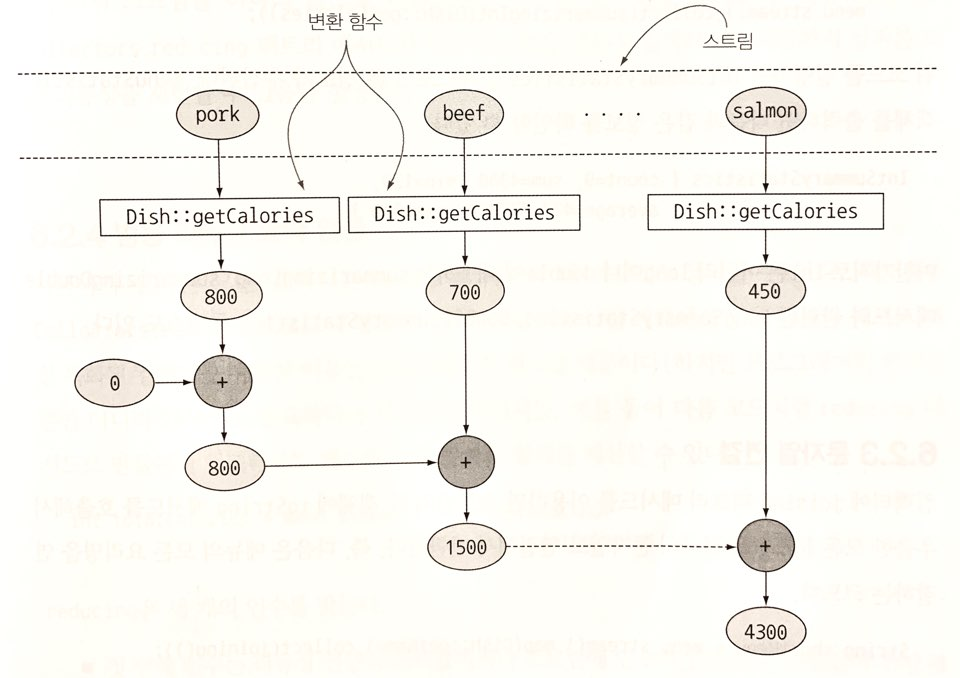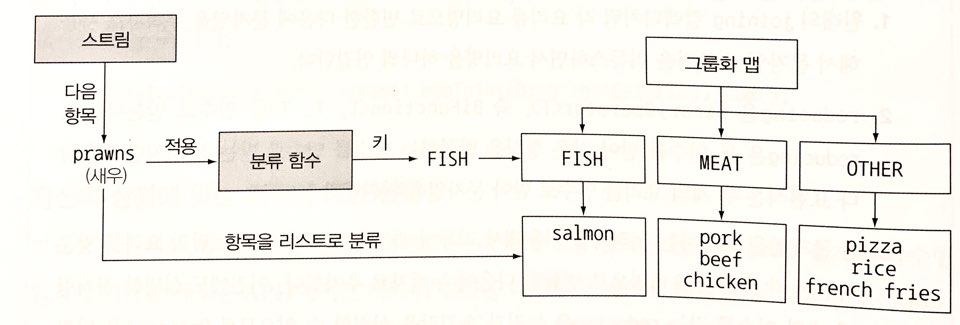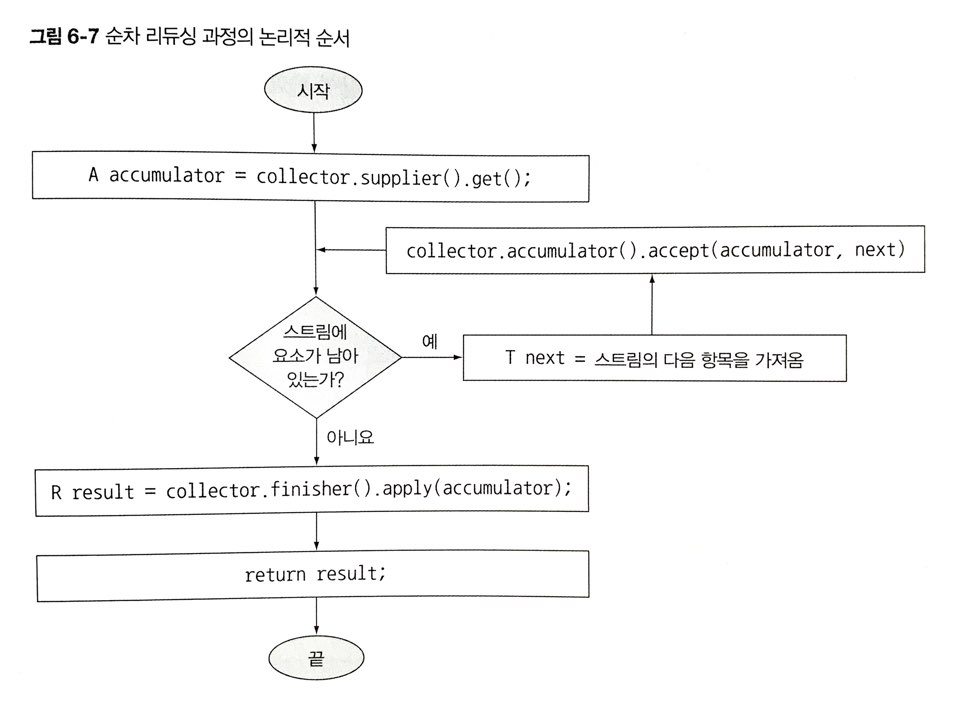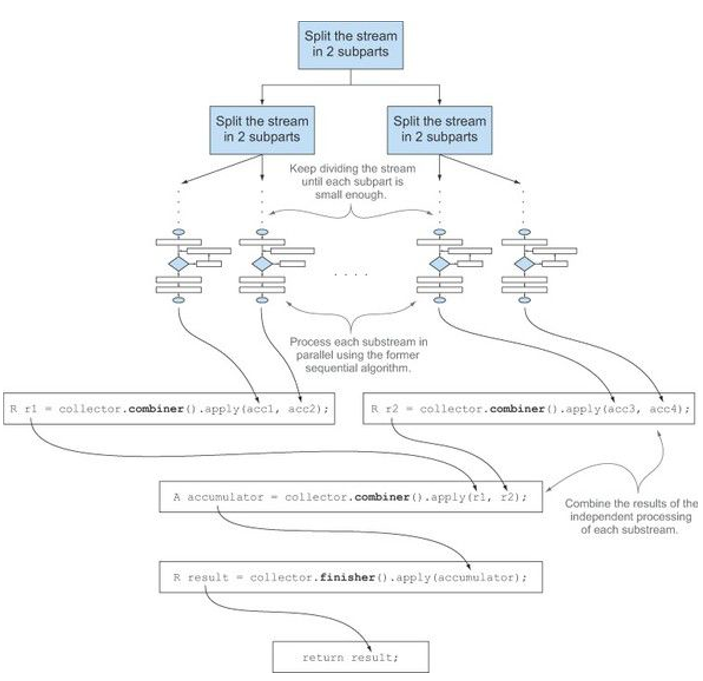예시로 시작해보자!!
- 통화별로 트랜잭션을 그룹화한 다음에 모든 트랜잭션 합계를 계산하는 예제
- 즉
Map<Currency, Integer>을 반환해야 한다. - 명령형 코드
- 코드가 길어서 무엇을 실행하는지 파악하기 어렵다.
Map<Currency, List<Transaction>> transactionByCurrencies = new HashMap<>(); // 그룹화한 트랜잭션을 저장할 맵을 생성
for (Transactin transaction : transactions) { // 트랜잭션 리스트를 반복
Currency currency = transaction.getCurrency();
List<Transaction> transactionsForCurrency = transactionsByCurrencies.get(currency);
if (transactionForCurrency = null) { // 현재 통화를 그룹화하는 맵에 항목이 없으면 항목을 만든다.
transactionsForCurrency = new ArrayList<>();
transactionsByCurrencies.put(currency, transactionsForCurrency);
}
transactinsForCurrency.add(transaction); // 같은 통화를 가진 트랜잭션 리스트에 현재 탐색 중인 트랜잭션을 추가
}- 함수형 코드
Map<Currency, List<Transaction>> transactionsByCurrencies = transactions.stream().collect(groupingBy(Transaction::getCurrency));이번 주제 키워드
reduce 연산(하나로 수렴)을 통해 스트림을 다양한 형태로 collect 하는 방법에 대한 내용
- Collectors
- reduce, reducing
- 데이터의 그룹화(groupingBy)와 분할(Predicate)
- Collector 인터페이스 살펴보기
- toList() 살펴보기
Collector란??
- 자바 8에서 Collector는 Stream 요소들을 어떻게 분류하고 모을지(reducing)를 담당하는 인터페이스이다.
- 즉
고급 리듀싱기능을 수행
- 즉
- Collector 인터페이스를 implement하고 구현하여 스트림의 요소를 어떤 식으로 도출할지 지정한다.
- 스트림에 collect()를 호출하면 스트림의 요소에 (컬렉터로 파라미터화된) 리듀싱 연산이 수행된다.
- 즉 collect에서는
리듀싱 연산을 이용해서 스트림의 각 요소를 방문하면서컬렉터가 작업을 처리한다. - 따라서 Collector 인터페이스의 메서드를 어떻게 구현하느냐에 따라 스트림에 어떤 리듀싱 연산을 수행할지 결정
- 즉 collect에서는

미리 정의된 컬렉터
Collectors 유틸티리 클래스에는 자주 사용하는 컬렉터 인스턴스를 쉽게 생설할 수 있는 정적 팩터리 메서드를 제공한다.
Collectors에서 제공하는 메서드의 기능은 크게 세가지
- 스트림 요소를 하나의 값으로 reduce하고 요약
- 스트림 요소들의 그룹화
- 스트림 요소들의 분할 (이것도 결국 bool 그룹화)
첫번째, Reducing과 요약
다양한 계산을 수행할 때 사용하는 유용한 컬렉터
- 스트림에 있는 객체의 숫자 필드의 합계나 평균 등을 반환하는 연산
counting()
- 다른 컬렉터와 함께 사용할 때 유용하다.
menu.stream().collect(Collectors.counting())
menu.stream().count()maxBy(), minBy()
- 스트림값에서 최댓값과 최솟값 검색할 때 사용하는 컬렉터
- 해당 컬렉터는 스트림의 요소를 비교하는데 사용할 Comparator인수를 받는다
Optional<Dish> mostCalorieDish = menu.stream().collect(Collectors.maxBy(Comparator.comparingInt(Dish::getCalories)));요약 연산
- 필드의 합계나 평균 등을 반환하는 연산
- 리듀싱 기능이 자주 사용된다.
- 대표적으로
Collectors.summingInt
public static <T> Collector<T, ?, Integer> summingInt(ToIntFunction<? super T> mapper) {
return new CollectorImpl<>(
() -> new int[1],
(a, t) -> { a[0] += mapper.applyAsInt(t); },
(a, b) -> { a[0] += b[0]; return a; },
a -> a[0], CH_NOID);
}@FunctionalInterface
public interface ToIntFunction<T> {
/**
* Applies this function to the given argument.
*
* @param value the function argument
* @return the function result
*/
int applyAsInt(T value);
}int totalColories = menu.stream().collect(summingInt(Dish:getCalories));- 위의 코드처럼
객체를 int로 매핑하는 함수를 인수로 받는다. - 인수로 전달된 함수는 객체를 int로 매핑한 컬렉터를 반환한다.
- summingInt가 collect 메서드로 전달되면 요약 작업을 수행한다.
- 이외에도 averagingInt 메서드도 존재한다.

만약 두 개 이상의 연산을 한번에 수행해야 할 때는?
summarizingInt()
IntSummaryStatistics statistic = menu.stream().collect(Collectors.summarizingInt(Dish::getCalories));
문자열 연결
joining()- 스트림의 각 객체에 toString 메서드를 호출해서 추출한 모든 문자열을 하나의 문자열로 연결해서 반환한다.
menu.stream().map(Dish::getName).collect(Collectors.joining(", "));
범용 리듀싱 요약 연산
이러한 모든 Collector는 reducing 팩토리 메서드로도 정의할 수 있다. (가독성이나 편리성 측면에서 권장하지 않는다)
reducing()
public static <T, U> Collector<T, ?, U> reducing(
U identity,
Function<? super T, ? extends U> mapper,
BinaryOperator<U> op) {
...
}- 첫 번째 인수 : reducing 연산의
초기값. 스트림에 인수가 없을 때는 반환값. - 두 번째 인수 : 요소를 변환하는
변환함수. - 세 번째 인수 : 같은 종류의 두 항목을 하나의 값으로 더하는
합계 함수(BinaryOperator.) - 예시 - 모든 메뉴 요소의 칼로리 합계
menu.stream().collect(Collectors.reducing(0, Dish::getCalories, (i, j) -> i + j)
menu.stream().collect(Collectors.reducing(0, Dish::getCalories, Integer::sum)한개짜리 인수를 갖는 reducing()
public static <T> Collector<T, ?, Optional<T>> reducing(BinaryOperator<T> op) {
...
}- 초기값은 스트림의 첫 요소
- 두번째 인수는 자신을 그대로 반환하는 항등 함수
- 따라서 빈 스트림인 경우를 대비해 Optional를 반환한다.
잠깐 BinaryOperator을 살펴보자
public interface BinaryOperator<T> extends BiFunction<T,T,T> {
}
@FunctionalInterface
public interface BiFunction<T, U, R> {
R apply(T t, U u);
}- 즉 두 인수의 타입과 반환하는 타입은 같아야 한다.
- 따라서 아래와 같은 사용은 컴파일 error
menu.stream().collect(Collectors.reducing((d1, d2) -> d1.getName() + d2.getName()))collect vs reduce
- 이 두가지 메서드로 같은 기능을 구현할 수 있지만 의미론적인 문제와 실용성 문제 등 몇가지 문제가 있다.
- 의미론적인 문제
- collect 메서드는 도출하려는 결과를 누적하는 컨테이너를 바꾸도록 설계된 메서드
- reduce 메서드는 두 값을 하나로 도출하는 불변형 연산
- 실용성 문제
- 여러 스레드가 동시에 같은 데이터 구조체를 고치면 리스트 자체가 망가져버리므로 리듀싱 연산을 병렬로 수행할 수 없다.
- 이를 피하기 위해 매번 리스트를 새로 할당하고 객체를 할당하느라 성능이 낮을 것 이다.
두번째, 그룹화
맨 처음 트랜잭션 currency 그룹화 예제를 생각해보면 명령형으로 그룹화를 구현하려면 까다롭고, 에러도 신경써야 하고, 코드가 길다.
Collectors.groupingBy이용하면 쉽게 그룹화가 가능하다.- gropingBy 메서드의 인수로 전달되는 함수를 기준으로 그룹화되므로 이를
분류 함수라고 부른다.

1. 타입에 따른 메뉴 그룹 구하기
Map<Dish.Type, List<Dish>> dishesByType = menu.stream().collect(Collectors.groupingBy(Dish::getType));
2. 복잡한 기준으로 그룹화하기
- 메서드 참조 대신 람다 사용
public enum CaloricLevel { DIET, NORMAL, FAT }
Map<CaloricLevel, List<Dish>> dishesByCaloricLevel = menu.stream().collect(
groupingBy(dish -> {
if (dish.getCalories() <= 400) {
return CaloricLevel.DIET;
} else if (dish.getCalories() <= 700) {
return CaloricLevel.NORMAL;
} else {
return CaloricLevel.FAT;
}
}));3. 다수준 그룹화
Map<Dish.Type, Map<CaloricLevel, List<Dish>>> dishesByTypeCaloricLevel =
menu.stream().collect(
groupingBy(Dish::getType,
groupingBy(dish -> {
if (dish.getCalories() <= 400) {
return CaloricLevel.DIET;
} else if (dish.getCalories() <= 700) {
return CaloricLevel.NORMAL;
} else {
return CaloricLevel.FAT;
}
})
)
);
// 결과
{FISH={NORMAL=[salmon], DIET=[prawns]}, OTHER={NORMAL=[fries, pizza], DIET=[rice, fruit]}, MEAT={FAT=[pork], NORMAL=[beef], DIET=[chicken]}}- n수준 그룹화를 통해 n 수준 맵이 된다.
4. 서브그룹으로 데이터 수집
- 분류 함수 한 개의 인수를 갖는 groupingBy(f)는 사실 groupingBy(f, toList())의 축약형이다.
- 따라서 요리의 종류를 분류하는 컬렉터로 메뉴에서 가장 높은 칼로리를 가진 요리를 찾는 로직도 구현할 수 있다.
Map<Dish.Type, Optional<Dish>> mostCaloricByType =
menu.stream().collect(groupingBy(Dish::getType, maxBy(comparingInt(Dish::getCalories))));
// 결과
{OTHER=Optional[pizza], MEAT=Optional[pork], FISH=Optional[salmon]}5. 컬렉션 결과를 다른 형식에 적용하기
- collectingAndThen은 적용할 컬렉터와 변환 함수를 인수로 받아 다른 컬렉터를 반환한다.
- 반환되는 컬렉터는 기존 컬렉터의 래퍼 역할을 하며 collect 마지막 과정에서 변환 함수로 자신이 반환하는 값을 매핑한다.
Map<Dish.Type, Dish> mostCaloricByType =
menu.stream()
.collect(groupingBy(Dish::getType, // 분류함수
collectingAndThen(maxBy(comparingInt(Dish::getCalories)), // 감싸인 컬렉터
Optional::get))); // 변환함수. Optional에 포함된 값을 추출세번째, 분할
분할은 분할 함수(프레디케이트)를 분류 함수로 사용하는 특수한 그룹화다
- 프레디케이트를 사용하므로 맵의 키 형식은 bool
- 따라서 두 개의 그룹으로 분류된다.
채식요리와 아닌 요리 분류
Map<Boolean, List<Dish>> partitionedMenu = menu.stream().collect(partitioningBy(Dish::isVegetarian));
// 결과 : {false=[pork, beef, chicken, prawns, salmon], true=[french fries, rice, season fruit, pizza]}분할의 장점
- filter를 사용해서도 간단히 원하는 내용을 얻을 수 있는데 왜 사용해야하는가?
- 참, 거짓 두가지 요소의 스트림 리스트를 모두 유지한다는 것이 장점이다.
- filter는 말그대로 필터링하여 보여주는 것이고, 분할은 데이터를 분할하는 용도로 사용하는 것이다.
- 두 번째 인수로 컬렉터를 사용하는 오버로드 메서드도 있다.
Map<Boolean, Map<Dish.Type, List<Dish>>> vegetarianDishesByType = menu.stream().collect(
partitioningBy(Dish::isVegetarian, // 분할 함수
groupingBy(Dish::getType))); // 두 번째 컬렉터
// 결과 :
{false={MEAT=[pork, beef, chicken], FISH=[prawns, salmon]},
true={OTHER=[french fries, rice, season fruit, pizza]}}지금까지 살펴본 모든 Collector는 Collector 인터페이스를 구현한다. Collector 인터페이스를 자세히 살펴보자.
Collector 인터페이스란?
- reducing 연산(Collector)를 어떻게 구현할지 제공하는 메서드 집합으로 구성된 인터페이스.
- Collector 인터페이스를 직접 구현하면 문제를 더 효율적으로 해결할 수 있다.
public interface Collector<T, A, R> {
Supplier<A> supplier();
BiConsumer<A, T> accumulator();
BinaryOperator<A> combiner();
Function<A, R> finisher();
Set<Characteristics> characteristics();- T는 수집된 스트림 항목의 제네릭 타입
- A는 누적자, 즉 수집 과정에서 중간 결과를 누적하는 객체의 타입
- R은 수집 연산 결과 객체의 타입
- 주로 컬렉션 타입
toList()를 확인해보면서 파악해보자!!
public static <T> Collector<T, ?, List<T>> toList() {
return new CollectorImpl<>((Supplier<List<T>>) ArrayList::new, List::add,
(left, right) -> { left.addAll(right); return left; },
CH_ID);
}supplier 메서드
새로운 결과 컨테이너 만들기
- supplier 메서드는 빈 결 이루어진 Supplier를 반환해야 한다.
@FunctionalInterface
public interface Supplier<T> {
T get();
}- 즉, supplier는 수집 과정에서 빈 누적자 인스턴스를 만드는 파라미터가 없는 함수다.
- toList()에서 supplier()은 빈 리스트를 반환한다.
public Supplier<List<T>> supplier() {
return () -> new ArrayList<T>();
}
public Supplier<List<T>> supplier() {
return ArrayList::new;
}accumulator 메서드
결과 컨테이너에 요소 추가하기
@FunctionalInterface
public interface BiConsumer<T, U> {
void accept(T t, U u);- 스트림에서 n번째 요소를 탐색할 때 누적자와 n번째 요소를 함수에 적용한다.,
- 함수의 반환값은 void, 즉 요소를 탐색하면서 적용하는 함수에 의해 누적자 내부 상태가 바뀌므로 누적자가 어떤 값일지 단정할 수 없다.
- toList()
public BiConsumer<List<T>, T> accumulator() {
return (list, item) -> list.add(item);
}
public BiConsumer<List<T>, T> accumulator() {
return List::add;
}finisher 메서드
최종 변환 값을 결과 컨테이너로 적용하기
- finisher 메서드는 스트림 탐색을 끝내고 누적자 객체를 최종 결과로 변환하면서 누적 과정을 끝낼 때 호출할 함수(Function<T, R>)를 반환해야 한다.
@FunctionalInterface
public interface Function<T, R> {
R apply(T t);
static <T> Function<T, T> identity() {
return t -> t;
}
}- 때로 누적자 객체가 이미 최종 결과인 상황도 있는데 이럴 때는 변환 과정이 필요하지 않으므로 finisher 메서드는 항등 함수를 반환한다.
- toList()도 마찬가지
public Function<List<T>, List<T>> finisher() {
return Function.identity();
}위 3가지 메소드는 순차적 스트림 리듀싱 기능을 수행할 수 있다. 하지만 실제로 collect가 동작하기 전, 다른 중간 연산과 파이프라인을 구성할 수 있게 해주는 게으른 특성 그리고 병렬 실행 등도 고려해야 하므로 스트림 리듀싱 기능 구현은 생각보다 복잡하다.

combiner 메서드 : 두 결과 컨테이너 병합
- combiner는 리듀싱 연산에서 사용할 함수를 반환하는 메서드이다.
- combiner는 스트림의 서로 다른 서브파트를 병렬로 처리할 때 누적자가 이 결과를 어떻게 처리할 지 정의한다.
public interface BinaryOperator<T> extends BiFunction<T,T,T> {
}
@FunctionalInterface
public interface BiFunction<T, U, R> {
R apply(T t, U u);
}- toList()의 경우
- 스트림의 두번째 서브 파트에서 수집한 항복 리스트를 첫 번째 서브파트 결과 리스트의 뒤에 추가하면 된다.
public BinaryOperator<List<T>> combiner() {
return (list1, list2) -> {
list1.addAll(list2);
return list1;
}
}- combiner 메서드를 이용하면 스트림의 리듀싱을 병렬로 수행할 수 있다.
- 이 때 자바7의 포크/조인 프레임워크와 Spliterator를 사용한다.

- 스트림의 분할을 정의하는 조건이 성립할 경우 원래 스트림을 재귀적으로 분할한다.
- 서브스트림의 각 요소에 리듀싱 연산을 순차적으로 적용하여 서브스트림을 병렬로 처리한다.
- combiner 메서드가 반환하는 함수를 통해 각 서브스트림의 결과를 합쳐 연산을 완료한다.
Characteristics 메서드
- Characteristics 메서드는 컬렉터의 연산을 정의하는 Charactieristics 형식의 불변 집합을 반환한다.
- Characteristics는 스트림을 병렬로 리듀스할건지, 그리고 병렬로 리듀스한다면 어떤 최적화를 선택해야 할지 힌트를 제공한다.
- Characteristics는 다음 세 항목의 특성을 갖는 열거형이다.
UNORDERED
- 리듀싱 결과는 스트림의 방문 순서나 누적 순서에 영향을 받지 않는다.
CONCURRENT
- 다중 스레드에서 accumulator 함수를 동시에 호출할 수 있으며 이 컬렉터는 스트림의 병렬 리듀싱을 수행할 수 있다.
- 컬렉터의 플래그에 UNORDERED를 함께 설정하지 않았다면 데이터 소스가 정렬되어 있지 않은(집합처럼 요소의 순서가 무의미한) 상황에서만 병렬 리듀싱을 수행할 수 있다.
DENTITY_FINISH
-
finisher 메서드가 반환하는 함수는 identity를 적용할 뿐이므로 이를 생략할 수 있다.
-
따라서 리듀싱 과정의 최종 결과로 누적자 객체를 바로 사용할 수 있다.
-
또한 누적자 A를 결과 R로 안전하게 형변환 할 수 있다.
-
toList()
- 마찬가지로 스트림의 요소를 누적하는데 사용한 리스트가 최종 결과 형식이므로 추가 변환이 필요 없다.
static final Set<Collector.Characteristics> CH_ID
= Collections.unmodifiableSet(EnumSet.of(Collector.Characteristics.IDENTITY_FINISH));요약
- collect는 스트림의 요소를 요약 결과로 누적하는 다양한 방법(컬렉터)을 인수로 갖는 최종 연산이다.
- 다양한 컬렉터 등이 Collections 유틸 클래스에 미리 정의되어 있다.
- 컬렉터는 다수준의 그룹화, 분할, 리듀싱 연산에 적합하게 설계되어 있다.
- Collector 인터페이스에 정의된 메서드를 구현해서 커스텀 컬렉터를 개발할 수 있다,